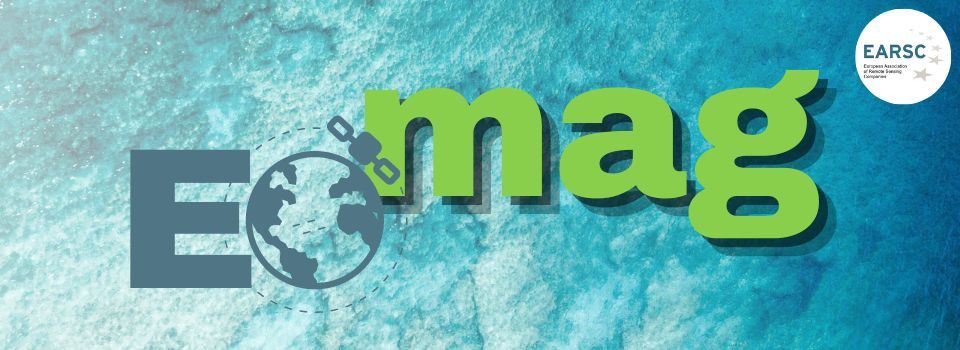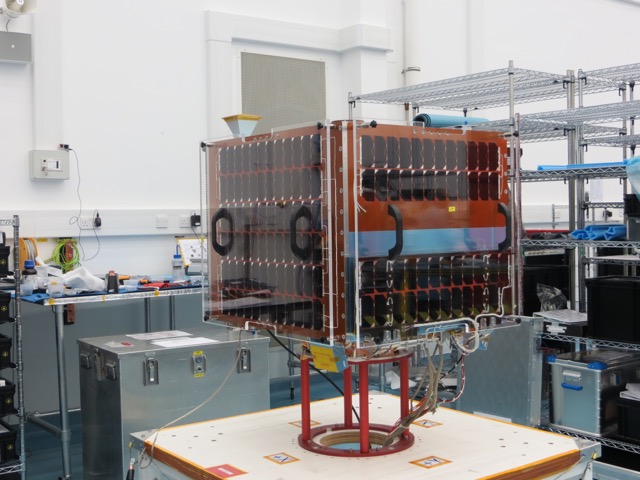The Company’s origins lie in academic research undertaken at University College London by Ray Purdy (a lawyer with an interest in evidence from EO) and Professor Ray Harris (an EO specialist with an interest in legal applications for EO), and although we are still an SME we now have an unrivalled blend of academic and military intelligence expertise in the legal, security and technical fields of EO. Fast Company listed us as one of their top 15 “World Changing Ideas” of 2015
Team photo. L-R: Jon Carver, Peter Hjerp, Ray Purdy (centre), Ray Harris, David Tellett
The company is deliberately very distinct from other organisations operating in the space sector. When we started out we decided the company would be built on four key ideas.
1. It would be deliberately interdisciplinary and focus on law and EO.
Unusually, we bring unrivalled interdisciplinary expertise in both Earth observation technologies and the law. Our approach is legally orientated but purposely holistic, and this enables us both to source imagery for clients and to interpret the findings from the imagery. We offer advice on EO data policy issues and the management, control and authentication of imagery to be used as evidence (including appearing as expert witnesses in court); the assessment of the correct technical procedures to apply to EO data and the implications of privacy legislation and search warrants; and the implications of implementing EO monitoring into regulatory, policy or industry programmes.
2. It would seek to help encourage the greater use of EO to some industry sectors that do not utilise it (and could do).
We believed that the opportunities for evidence collection presented by EO would become progressively more important to those working in fields where formal evidence was important (e.g. law firms, insurance companies, regulatory bodies). Our experience in academia was that many of those working in these sectors had little awareness, knowledge or understanding as to what EO technologies can offer, its limits and its value as evidence. Further, we received many calls to the university from law firms and regulatory bodies asking how they might get imagery, which could potentially be used in evidence in legal disputes. These sectors had little idea where EO imagery could be sourced from or the evidential implications of using it. Spotting a gap in the market, Air & Space Evidence sought to bridge the link between the imagery from EO technologies and those working in a legal context. We spend a lot more time going to events which have prospective clients rather than interacting with other members of the EO industry – not because we don’t want to talk to other people in our sector, but because we want to focus spending our time finding out what potential applications there might be for the data. Our largest number of enquiries relates to criminal investigations and also environmental regulation.
3. It would give greater opportunities for the general public to use EO data.
There are significant opportunities available in looking back in time and EO archives are important as they can often provide historical (legal) evidence that would be otherwise unavailable. We wanted to seek to help move commercial remote sensing from the world of intelligence uses by the military and government agencies to the world of commerce. The general public is a huge market and we considered that there would be interest in a service whereby they could get access to EO data that could be used in an evidential context. To enable this, we marketed ourselves in a way that we thought would be understandable and engaging to the public at large – we styled ourselves as the World’s First Space Detective Agency. We have found that the public is very interested in EO as evidence. Most of our cases relate to planning disputes, but we deal with a large volume of different types of enquiry. One key problem we have encountered is managing people’s expectations following TV programmes like Homeland, Spooks and Hollywood films like Enemy of the State.
4. It would seek to communicate the value of EO to the media.
We also felt that the EO industry can sometimes be viewed as being in a bubble that doesn’t always connect sufficiently well with the outside world. We wanted to seek to promote the use and value of EO within the media. We also wanted to initiate debates that we considered important such as the privacy implications of EO. We have found that the media are extremely interested in EO and very willing to publish stories in this area (especially as the term ‘space detective agency” importantly did seem to strike a chord). In our short life span the company has been covered on TV, radio and the internet by national broadcasters such as BBC, Sky and CNN; national newspapers from many countries across the world; scientific publications like the New Scientist, Scientific American, Environmental Scientist; public interest magazines such as Wired, Fact Company, Quo and Vice; and industry sector publications. Whilst media communication can be time consuming and does not directly result in income, it can still be rewarding.
COMPANY GOALS AND SUCCESS STORIES
Whilst it has been extremely interesting building up the company and handling enquiries from the public and government, we also wanted to ensure that there was a regular flow of income into the company. This meant designing and selling our own monitoring services. At the same time, we also wanted to tackle a problem that was hugely problematic for society at large.
We decided to tackle the issue of waste crime, because this was increasingly causing significant damage to society and is estimated to cost the UK (where we are based) more than a billion pounds sterling a year. It is estimated to cost all EU countries €72 – 90 billion per annum. Interpol, Europol and the UN have identified waste crime as one of the fastest growing areas of organised crime. It is increasingly recognized to have the potential to rival drug trafficking in terms of scale and profits. Waste crime can also cause environmental damage to surrounding land, air and water, and poses a risk to human and animal health. Living near an unlawful waste site can also ruin people’s lives. Our aim was to try and use EO technology to significantly reduce the scale of the waste crime problem.
The key problem with waste crime was that it was often hard to detect – or to detect quickly before the damage is done and the criminal gangs have moved on. We decided to develop a semi-automated detection model, using satellite and map data from open data sources to detect unlawful waste dumping sites, whereby we could identify waste crime that governments are not aware of, bringing immense value to their work and enabling them to catch more waste crime gangs in the act.
Air & Space Evidence received funding for three projects in the last year:
- The ASE team won a major award from the European Open Data Incubator to test the semi-automated detection model. Three sets of trials were conducted in Northern Ireland, with the cooperation of the Northern Ireland Environment Agency, to determine the effectiveness of the detection model. The model had a 71% success rate in detecting illegal waste sites.
- We undertook a project for the Scottish Environmental Protection Agency examining remote sensing technology developments and their potential to detect waste crime. The ASE team conducted an examination of the types of waste crime problems that were taking place, and undertook a detailed technical assessment of which ones might benefit from remote sensing evidence. We then designed trials which will test the usefulness of remote sensing data in practice for detecting waste crime at both licensed and unlicensed sites.
- ASE were part of a consortium (with Telespazio Vega UK) that won an ESA project on “Space Based Support Services for Waste Management”. The project (which has only just started) will examine how a combination of space imaging, satellite tracking and monitoring technologies can be used to tackle and enhance two specific problems facing the waste management sector – the tracking of waste and the illegal dumping of waste, and will demonstrate whether there is a business case for such a service.
An image from a potentially illegal waste site that we were investigating
We have developed a service called Waste from Space based on the work in the above projects. Finding illegal waste sites is a bit like finding a needle in a haystack. They can be concealed, be different shapes and sizes, and be in a wide variety of locations. To tackle this, we combined a variety of techniques from both radar and optical satellite sensors, aided by mapping data, to discriminate standard land use types, concentrating on anomalies. We effectively focused on finding the needle by eliminating the haystack. Our technique discards the vast majority of items in the search area and allows us to isolate a realistic number of suspicious areas for further close-up satellite investigation.
Air and Space Evidence were this year’s winners of the European Earth Observation Product of the Year award. This award, given by the European Association of Remote Sensing Companies (EARSC), was for our Waste from Space product, and was received at a ceremony in Brussels on 4 July 2017. Our product was selected because it supported the implementation of some of the key United Nations sustainable development goals (and the monitoring and reporting of these against the global indicator framework), in the most innovative way. Winning was a huge surprise and we were really very honoured to have been selected.
Receiving the EARSC Product award: Jon Carver, Air and Space Evidence and Rob Postma, Airbus and event sponsor
We are currently engaging with governments, environment agencies, EU bodies and supranational environmental compliance networks to discuss regulatory needs and the potential opportunities of implementing space based technologies into regulatory regimes to ensure better waste crime monitoring and compliance. A high-level workshop is to be held in Brussels in co-operation with DG Environment of the European Commission in late October 2017 to discuss the role of space technology in tackling waste crime. The Commission are involved as they are very supportive of the use of EO to tackle the growing problem of waste crime, and they also think our approach is very relevant to the promotion of Copernicus and the INSPIRE Directive.

